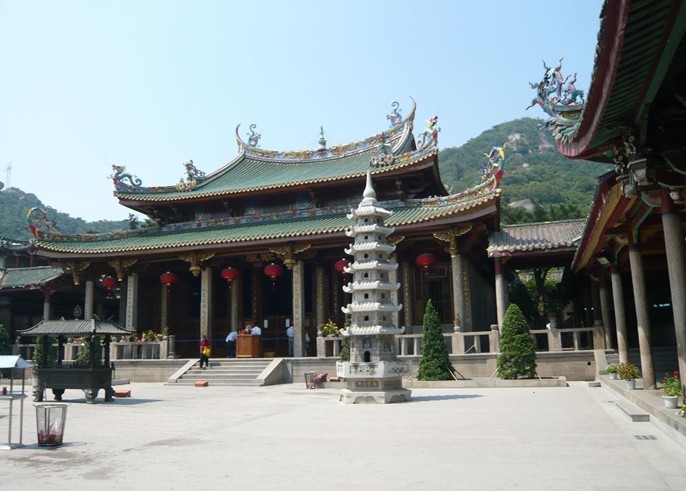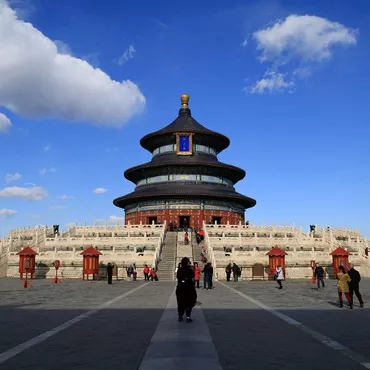Nanputuo Temple
Located in the southern part of Xiamen old downtown, Nanputuo Temple Scenic Area Starts from South Siming Road and ends by Hulishan seashore, the scenic area including Hongshan Park, Overseas Chinese Museum, Nanputuo Temple, Huli Shan Old Fortress, along with Lu Xun Memorial Hall, Museum of Anthropology and Memorial Hall of Mr. Tan Kah-kee in Xiamen University.


Nanputuo Temple is situated below the Five Old Gentlemen Peaks in the southern part of the island of Xiamen. It was first built in the Tang Dynasty and is one of the sacred places of Buddhism in Southern Fujian. Inside the temple there are the Heaven King's Hall, the Daxiong Hall, the Great Compassion Hall, all of which are built in an exquisite and grand style.
Enshrined in these halls are the statues of Maitreya, Sanshi Reverend Buddha, Thousand-handed Guanyin (Bodhisattva), Four Kings of Heaven, and the eighteen archats. Although all are serious and solumn in appearance, each is distinctly different from another. The temple attracts a large number of pilgrims at home and abroad. The excellent craftsmanship of the Thousand-handed Guanyin is marked by its thousand hands and thousand eyes and glistening golden colour.


In the temple many inscriptions are preserved, among which the stone inscriptions written by Chen Di and Sheng Yourong in the Wanli period of the Ming Dynasty and the one on a stone stele written by Emperor Kangxi period of the Qing Dynasty are most famous. Behind the temple, inscribed on the wall of a rock is a large word "Buddha" which is 4.66 metres in height and 3.33 metres in width. And farther behind, high up on the mountain stands a screen of five peaks coloured by green trees and bamboos and marked by serene valleys and rocks of pleasing shapes. They are called "Five Old Gentlemen Reaching the Clouds," and are one of the eight grand sights of Xiamen. Coming to the top, you not only have a view of the mountain undulating in the wind, but also the view of the sea surging in the distance.
As to the Pavilion where Buddhist scriptures are kept, it has a rich collection of the historical articles of Buddhism, such as classics, statues of Buddhas, bronze bells from the Song Dynasty, calligraphic works and paintings from the ancient times. Among them, "Intriguing Lotus Scripture" written in blood in the Wanli period of the Ming Dynasty and the statue of Guanyin in white porcelain, a masterpiece of He Chaosong, are most valuable.
Behind Nanputuo Temple, inscribed on the wall of a rock is a large word "Buddha" which is 4.66 metres in height and 3.33 metres in width. And farther behind, high up on the mountain stands a screen of five peaks coloured by green trees and bamboos and marked by serene valleys and rocks of pleasing shapes. They are called "Five Old Gentlemen Reaching the Clouds," and are one of the eight grand sights of Xiamen.
Look from far, the five peaks wreathed by clouds are just like five old men with white beard and hair who have experienced enough swift changes of the world and are looking far into the vast sea. Coming to the top, you not only have a view of the mountain undulating in the wind, but also the view of the sea surging in the distance.
At the foot of Fengchao (Beehive) Hill is the six-hectare Overseas Chinese Museum. Founded by the eminent overseas Chinese philanthropist Tan Kah-kee, it has three exhibition halls which have on display 1,200 pictures and documents which truely chronicle the past and current state of overseas chinese society abroad, 2,000 rare cultural relics, l,000 objects related to the history of Chinese who emigrated overseas and over 1,000 pieces of specimens of rare animals, birds and marine lives. The museum is open to the public since 1959 and long enjoys the reputation of "the world's unique museum on history of overseas chinese".
This fortress was built in Huli Shan coast in the southwest part of Xiamen Island in 1891 during the Qing Dynasty. The fortress was completed within five years. Huli Fort boasts The World of Exotic Stones, and an exhibition of ancient armaments. But its real claim to fame is the 60 ton German-made coastal defense gun installed by some big shot back in 1896.
The fortress is equipped with two main Krupp cannons in eastern and western fortifications with two supplementary cannons beside them separately. The 280mm cannons are 13.96 meters long, weighing 60 tons, with effective range of 6460 meters. The cannons,worth 60,000 taels of silver each, are the largest ones of the same kind in the world and can be regarded as "King of Cannons". In 1989, an iron cannon put into the sea by Britain troops was dredged up and then another smaller one made in German was dug out from underground in the northern gate to the
fortification. These are two of the 12 cannons of the fortification.













